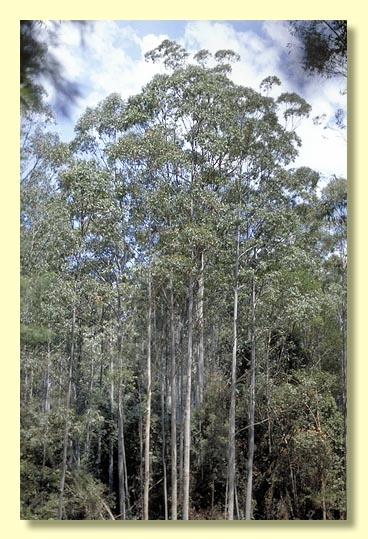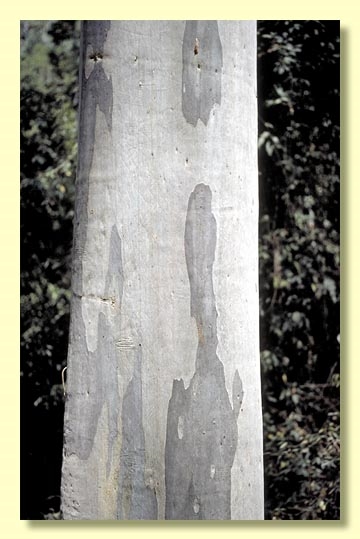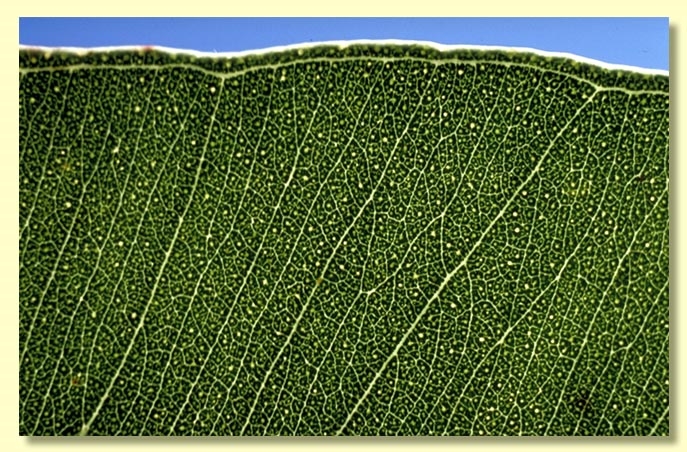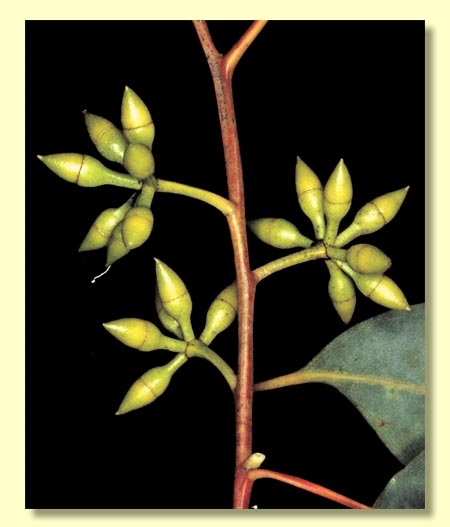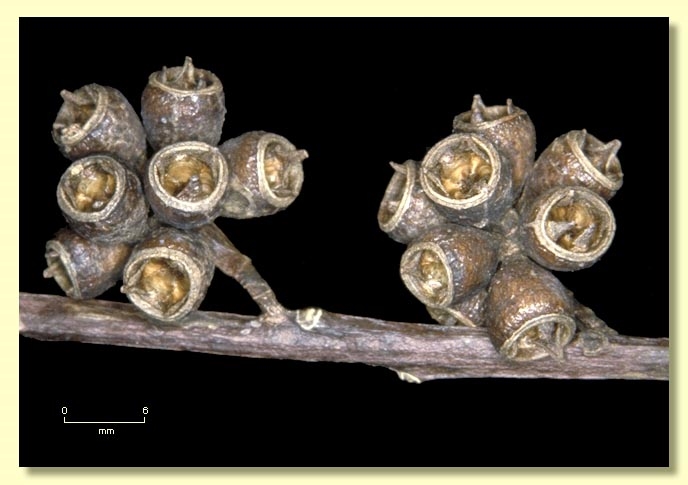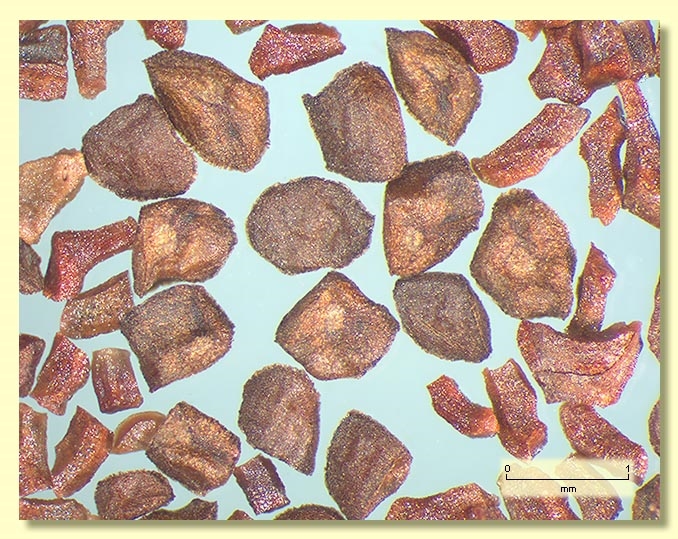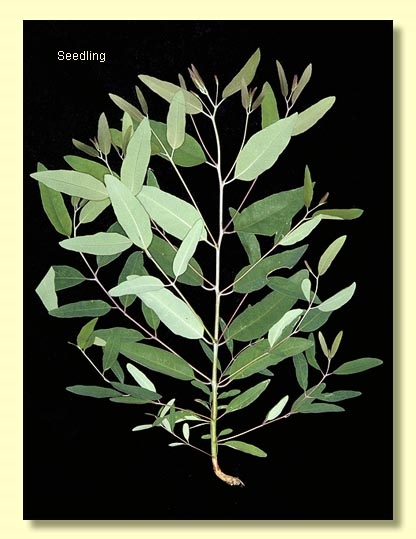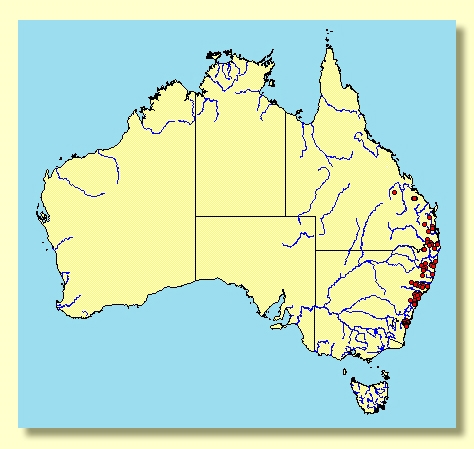Euclid - Online edition
Eucalyptus saligna
Eucalyptus | Symphyomyrtus | Latoangulatae | Transversae
T: Port Jackson, NSW, 1794, J.White s.n.; holo: LINN; iso: BM, G.
Eucalyptus saligna var. protrusa Blakely & McKie in W.F.Blakely, Key Eucalypts 96 (1934). T: Diehard State Forest, Glen Innes district, NSW, 9 June 1932, E.N.McKie s.n.; holo: NSW.
Bark rough and flaky, grey to grey-brown on basal 1–4 m of trunk, smooth above, bluish grey to cream, green, pink or brown.
Juvenile growth (coppice or field seedlings to 50 cm): stem rounded in cross-section, warty or smooth; juvenile leaves always petiolate, opposite for 4 or 5 pairs then alternate, lanceolate to ovate or oblong, 3.7–12 cm long, 1.5–4 cm wide, margin entire or slightly crenulate, discolorous, green.
Adult leaves alternate, petiole 1.5–3 cm long; blade lanceolate to falcate, 9–19 cm long, 1.5–4 cm wide, base oblique or tapering to petiole, discolorous, glossy, green, strongly penniveined, densely to very densely reticulate, intramarginal vein parallel to and just within margin, oil glands island, intersectional or obscure.
Inflorescence axillary unbranched, peduncles 0.5–1.5 cm long, buds 7, 9 or 11, sessile or pedicellate (pedicels 0–0.5 cm long). Mature buds fusiform to ovoid or diamond-shaped (0.5–1 cm long, 0.3–0.5 cm wide), green, scar present, operculum conical or beaked, stamens irregularly flexed, anthers cuboid to oblong, versatile, dorsifixed, dehiscing by longitudinal slits (non-confluent), style long, stigma blunt or tapered, locules 3 or 4, the placentae each usually with 4 vertical ovule rows. Flowers white.
Fruit sessile or pedicellate (pedicels 0–0.5 cm long), cylindrical to obconical or cup-shaped, 0.4–0.9 cm long, 0.4–0.7 cm wide, disc descending, valves 3 or 4, exserted and erect.
Seeds brown, 1–2 mm long, cuboid or ovoid, dorsal surface pitted, hilum ventral.
Cultivated seedlings (measured at ca node 10): cotyledons bilobed; stems square or rounded in cross-section; leaves always petiolate, opposite for 5 to 7 nodes then alternate, ovate-lanceolate, 4.5–9 cm long, 2–4 cm wide, base tapering to rounded, margin entire, apex pointed or blunt, discolorous, dark green above, paler beneath.
Flowering has been recorded in January, February and March.
Eucalyptus saligna has been used in the timber industry for general construction, flooring, cladding, panelling. It is also used by apiarists for honey production.
In Western Australia Eucalyptus saligna has escaped from plantings and become naturalised (Hussey et al., 1997).
A medium-sized to tall forest tree of south coastal New South Wales from about Batemans Bay north to the eastern margin of the Northern Tablelands, and to south-eastern Queensland where it occurs more inland west and north-west of Brisbane, e.g. Toowoomba and, disjunctly, further north to Kroombit Tops and Blackdown Tableland. Bark of Eucalyptus saligna is rough at the base and smooth above and the crown leaves are glossy green on the upper side and paler on the underside.
Eucalyptus saligna is related to E. grandis which occurs from Newcastle in New South Wales as far north as the Atherton and Windsor Tablelands in Queensland. E. grandis differs from E. saligna in the lack of a lignotuber and in the fruit which have four or five incurving more or less whitish valves. In the southern part of its distribution E. saligna intergrades with the rough-barked E. botryoides and many populations south of Sydney, e.g. Kangaroo Valley, cannot be assigned to one or the other species. E. deanei differs in being completely smooth-barked and having persistent, glossy, ovate, juvenile leaves in the lower crown. Another tall forest white gum occurring within the range of E. saligna is E. dunnii of north coastal New South Wales, which differs in having subopposite elliptic-ovate juvenile leaves slightly glaucous at times and fruit that are hemispheric to obconical and have an obvious level to ascending disc and prominently exserted valves.
Eucalyptus saligna belongs in Eucalyptus subgenus Symphyomyrtus section Latoangulatae because cotyledons are bilobed, leaves are discolorous and have side-veins at a wide angle to the midrib, buds have two opercula, the oputer shed early, and fruit have exserted valves. Within this section, E. saligna is one of three species forming series Transversae because ovules are in four rows, seeds are ovoid to cuboid and bark is predominantly smooth (a short rough stocking). The other two species are E. deanei and E. grandis, which differ as outlined above.

